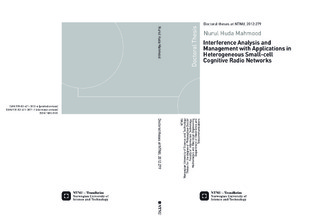| dc.contributor.author | Mahmood, Nurul Huda | nb_NO |
| dc.date.accessioned | 2014-12-19T13:48:17Z | |
| dc.date.accessioned | 2015-12-22T11:47:46Z | |
| dc.date.available | 2014-12-19T13:48:17Z | |
| dc.date.available | 2015-12-22T11:47:46Z | |
| dc.date.created | 2013-01-25 | nb_NO |
| dc.date.issued | 2012 | nb_NO |
| dc.identifier | 600726 | nb_NO |
| dc.identifier.isbn | 978-82-471-3872-4 (printed version) | nb_NO |
| dc.identifier.isbn | 978-82-471-3871-7 (electronic version) | |
| dc.identifier.uri | http://hdl.handle.net/11250/2370675 | |
| dc.description.abstract | This thesis examines interference modeling and management in small cell cognitive radio networks.
A generalized unified statistical model is presented for the interference from a heterogeneous next generation network at a target receiver located at the centre of a cell. The derived model is then applied in devising a simple distributed power allocation algorithm for the next generation network nodes, and in the various performance analyses of the the coexisting systems.
Cooperative communication improves the outage performance and coverage of wireless links under certain channel conditions, but is not spectrally efficient when channel conditions are favorable. A hybrid cooperation technique that can reap the diversity benefits of cooperative communication without sacrificing the multiplexing gain is proposed, and the performance of an interference temperature constrained cognitive radio network employing the proposed cooperation technique is analyzed.
Next, a formulation of the power allocation problem in the cognitive interference channel is presented whereby the interference margin at the primary receivers are seen as resources to be shared optimally. A relative rate utility based power allocation algorithm that is shown to achieve favorable sum throughput is then proposed.
Finally, the thesis investigates various interference coordination techniques for multi antenna cognitive radio users coexisting with multiple primary users under a restricted interference temperature constraint. Knowledge of the zero forcing beamforming techniques and the interference alignment schemes are applied to satisfy the restricted interference temperature constraint at the primary receivers while supporting significant sum rate at the secondary system. | nb_NO |
| dc.language | eng | nb_NO |
| dc.publisher | Norges teknisk-naturvitenskapelige universitet, Fakultet for informasjonsteknologi, matematikk og elektroteknikk, Institutt for elektronikk og telekommunikasjon | nb_NO |
| dc.relation.ispartofseries | Doktoravhandlinger ved NTNU, 1503-8181; 2012:279 | nb_NO |
| dc.relation.haspart | Mahmood, N. H.; Yilmaz, F.; Alouini, M.-S.; Øien, G. E.. Interference Modeling for Heterogeneous Next Generation Wireless Networks - and its Applications. . | nb_NO |
| dc.relation.haspart | Mahmood, N. H.; Yilmaz, F.; Øien, G. E.; Alouini, M.-S.. On Hybrid Cooperation in Underlay Cognitive Radio Networks. | |
| dc.relation.haspart | Mahmood, Nural Huda; Øien, Geir Egil; Lundheim, Lars Magne; Salim, Umer. A Relative Rate Utility based Distributed Power Allocation Algorithm for Cognitive Radio Networks. Proceedings of the 2012 International WDN Workshop on Cooperative and Heterogeneous Cellular Networks (WDN-CN2012): 136-142, 2012. <a href='http://dx.doi.org/10.1109/PIMRC.2012.6362560'>10.1109/PIMRC.2012.6362560</a>. | |
| dc.relation.haspart | Mahmood, N. H.; Øien, G. E.. Generalized Hierarchical Spectrum Usage under Spatio-orthogonal Co-existence Policy. | |
| dc.title | Interference Analysis and Management with Applications in Heterogeneous Small-cell Cognitive Radio Networks | nb_NO |
| dc.type | Doctoral thesis | nb_NO |
| dc.contributor.department | Norges teknisk-naturvitenskapelige universitet, Fakultet for informasjonsteknologi, matematikk og elektroteknikk, Institutt for elektronikk og telekommunikasjon | nb_NO |
| dc.description.degree | PhD i elektronikk og telekommunikasjon | nb_NO |
| dc.description.degree | PhD in Electronics and Telecommunication | |
